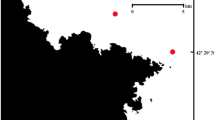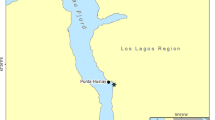Abstract
To establish a complete understanding of reproductive variability, larval supply and ultimately population demographics of a species it is important to determine reproduction across a broad spectrum of environmental conditions. This study quantified sexual reproduction of the brooding, gonochoristic sponge Rhopaloeides odorabile from populations across the shelf reefs of the central Great Barrier Reef (GBR). Histological sections of reproductive sponges collected at increasing distances from the coast were used to determine if numbers of reproductive sponges, reproductive output (using a reproductive output index), size at sexual maturity, and sex ratios varied according to their location (distance) from the coastline and therefore from influences of terrigenous/riverine discharge. Significantly higher proportions of reproductive sponges occurred with increasing distance from the coast. The proportion of all reproductive sponges (both male and female) on offshore reefs ranged from 77 to 90%, during November and December, the peak reproductive months of this sponge, compared to 47 to 50% for sponges occurring on coastal reefs. Levels of female reproduction increased with increasing distance from the coastline on two levels. First, oocytes from offshore sponges were significantly larger than oocytes from coastal sponges. Second, sponges from offshore reefs showed a reproductive index (proportions of oocytes, embryos and larvae mm−2) approximately 15 times higher than coastal reef sponges. Therefore, both numbers of oocytes, embryos and larvae in conjunction with larger oocytes contribute to a higher reproductive output index for offshore sponges. The production of spermatic cysts in males was consistent across the GBR. Sex ratios for coastal reef sponges showed a male bias while offshore sponges showed approximate equal sex ratios. The effect of terrigenous riverine input from coastal fluvial plains to the inner GBR is well established and is likely to contribute to the lower levels of reproduction associated with female sponges inhabiting coastal reefs of the central GBR.





Similar content being viewed by others
References
Airoldi L (2003) The effects of sedimentation on rocky coast assemblages. Oceanogr Mar Biol Annu Rev 41:161–236
Anthony KR, Fabricius KE (2000) Shifting roles of heterotrophy and autotrophy in coral energetics under varying turbidity. J Exp Mar Biol Ecol 252:221–253
Bateman AJ (1948) Intrasexual selection in Drosphila. Heredity 2:349–368
Carballo JL (2006) Effect of natural sedimentation on the structure of tropical rocky sponge assemblages. Ecoscience 13:119–130
Devlin MJ, Brodie J (2005) Terrestrial discharge into the Great Barrier Reef Lagoon: nutrient behaviour in coastal waters. Mar Pollut Bull 51:9–22
Duckworth A, Battershill C (2003) Sponge aquaculture for the production of biologically active metabolites: the influence of farming protocols and environment. Aquaculture 221:311–329
Fabricius KE (2005) Effects of terrestrial runoff on the ecology of corals and coral reefs: review and synthesis. Mar Pollut Bull 50:125–146
Fabricius KE, De’ath G (2001a) Environmental factors associated with the spatial distribution of crustose coralline algae on the Great Barrier Reef. Coral Reefs 19:303–309
Fabricius KE, De’ath G (2001b) Biodiversity on the Great Barrier Reef: large scale patterns and turbidity-related local loss of soft coral taxa. In: Wolanski E (eds) Oceanographic processes of coral reefs: physical and biological links in the Great Barrier Reef. CRC Press, London, pp 127–144
Fabricius KE, De’ath G (2004) Identifying ecological change and its causes: a case study on coral reefs. Ecol Appl 14(5):1448–1465
Fabricius KE, Wolanski E (2000) Rapid smothering of coral reef organisms by muddy marine snow. Estuar Coast Shelf Sci 50:115–120
Fabricius KE, De’ath G, McCook L, Turak E, Williams DM (2005) Changes in algal, coral and fish assemblages along water quality gradients on the inshore Great Barrier Reef. Mar Pollut Bull 51:384–398
Fromont J (1999) Reproduction of some demosponges in a temperate Australian shallow water habitat. Mem Queens Mus 44:185–192
Gerrodette T, Flechsig AO (1979) Sediment-induced reduction in the pumping rate of the tropical sponge Verongia lacunosa. Mar Biol 55:103–110
Gilmour J (1999) Experimental investigation into the effects of suspended sediment on fertilisation, larval survival and settlement in a scleractinian coral. Mar Biol 135:451–462
Hall VR, Hughes TP (1996) Reproductive strategies of modular organisms: comparative studies of reef building corals. Ecology 77:950–963
Haynes D, Michalek-Wagner K (2000) Water quality in the Great Barrier Reef World Heritage Area: past perspectives, current issues and new research directions. Mar Pollut Bull 41:428–434
Haynes D, Muller J, Carter S (2000) Pesticide and herbicide residues in sediments and seagrasses form the Great Barrier Reef world heritage area and Queensland coast. Mar Pollut Bull 41:279–287
Haynes D, Carter S, Gaus C, Mueller J, Dennsion W (2005) Organochlorine and heavy metal concentrations in the blubber and liver tissue collected from Queensland (Australia) dugong (Dugon dugon). Mar Pollut Bull 51:361–369
Lechowicz MJ, Blais PA (1988) Assessing the contributions of multiple interacting traits to plant reproductive success: environmental dependence. J Evol Biol (1):255–273
McCulloch M, Fallon S, Wyndham T, Hendy E, Lough J, Barnes D (2003) Coral record of increased sediment flux to the inner Great Barrier Reef since European settlement. Nature 421:727–730
McEdward LR, Morgan KH (2001) Interspecific relationships between egg size and the level of parental investment per offspring in echinoderms. Biol Bull 200:33–50
Reiswig HM (1971) Particle feeding in natural populations of three marine demosponges. Biol Bull 141:568–591
Roberts DE, Davis AR, Cummins SP (2006) Experimental manipulation of shade, silt, nutrients and salinity on the temperate reef sponge Cymbastela concentrica. Mar Ecol Prog Ser 307:143–154
Rogers CS (1990) Responses of coral reefs and reef organisms to sedimentation. Mar Ecol Prog Ser 62:185–202
Tanner J (1995) Competition between scleractinian corals and macroalgae. An experimental investigation of coral growth, survival and reproduction. J Exp Mar Biol Ecol 190:151–158
Tanner J (1997) Interspecific competition reduces fitness in scleractinian corals. J Exp Mar Biol Ecol 214:19–34
Telesnicki GJ, Goldberg WM (1995) Effects of turbidity on the photosynthesis and respiration of two south Florida reef coral species. Bull Mar Sci 57:527–539
Underwood AJ, Chapman MG, Connell SD (2000) Observations in ecology: you cannot make progress on processes without understanding the patterns. J Exp Mar Biol Ecol 250:97–115
Uriz MJ, Turon X, Becerro MA, Galera J, Lozano J (1995) Patterns of resource-allocation to somatic, defensive, and reproductive functions in the Mediterranean encrusting sponge Crambe crambe (Demospongiae, Poecilosclerida). Mar Ecol Prog Ser 124:159–170
Whalan S, Battershill C, de Nys R (2007) Sexual reproduction of the brooding sponge Rhopaloeides odorabile. Coral Reefs 26:655–663
Wilkinson CR, Cheshire AC (1989) Patterns in distributions of sponge populations across the central Great Barrier Reef. Coral Reefs 8:127–134
Wulff JL (1997) Mutualisms among species of coral reef sponges. Ecology 78:146–159
Acknowledgments
This project was part of the sponge aquaculture programme of AIMS@JCU, which receives funding and in kind support from the Australian Institute of Marine Science, James Cook University Research Advancement Programme (Finfish and Emerging Aquaculture), Great Barrier Reef Research Foundation, Coolgaree Aboriginal Corporation, Queensland Department of State Development, Innovation and Trade, Queensland Department of Primary Industries and Fisheries, and the Commonwealth Department of Transport and Regional Services. Funding was also received from the Linnean Society of NSW. We thank D. Cocker, A. Lynch, M. Depczynski and W. Dunlap for assisting in sample collections and N. Paul for statistical advice.
Author information
Authors and Affiliations
Corresponding author
Additional information
Communicated by S.D. Connell.
Rights and permissions
About this article
Cite this article
Whalan, S., Battershill, C. & de Nys, R. Variability in reproductive output across a water quality gradient for a tropical marine sponge. Mar Biol 153, 163–169 (2007). https://doi.org/10.1007/s00227-007-0792-z
Received:
Accepted:
Published:
Issue Date:
DOI: https://doi.org/10.1007/s00227-007-0792-z




